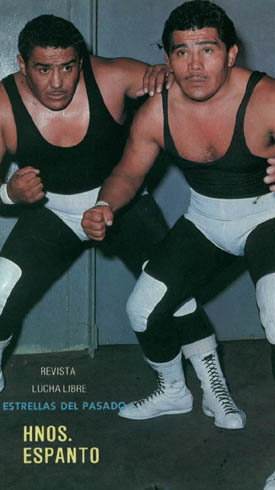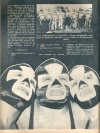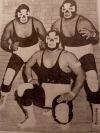Los Hermanos Espanto
Profile
| Los Hermanos Espanto (The Espanto Brothers) I, II and III | |||||||||||||||||||||||||||||
 |
|
||||||||||||||||||||||||||||
Biography
The Espantos are one of those teams that you can't overlook while talking about Mexican wrestling history, however they are an undeservedly often forgotten team by modern Mexican fans and historians, and practically a team of unknowns to English speaking fans.
The Espantos are one of the first "gimmicked trios" to ever be in the world, and they were really popular even though they didn't skyrocket the popularity of six-men tag matches like "Los Misioneros de la Muerte" (Signo, Texano and Negro Navarro). However, Los Misioneros can be compared to Los Espanto in many ways. Both teams always were rudos, but they had such incredible charisma that they could sell out arenas full of fans that would cheer for them: "Los Sustos" or "Los Tinacos", as they were known among the fans (even though those names were given to them by a writer of the sports newspaper La Afición).
The first Espanto, José Eusebio Vázquez Bernal was born in 1933, the second Espanto, Fernando Cisneros Carrillo was born on August 25, 1932, and the younger Espanto, Miguel Vázquez Bernal was born in 1942, all of them in the "Lagunero" city of Torreón, Coahuila. Looking by their last names (Hispanic people have two surnames), can be seen that they all aren't really brothers, only two of them are. So their case can be seen like the one of "Los Hermanos Shadow", Blue Demon and Black Shadow, though the Espanto relationship was much stronger than the one of the Shadows was. Espanto II isn't a legitimate brother of the other two Espantos, but since childhood, Eusebio and Fernando were like brothers.
Their friendship was born the second year of primary school at the Escuela México (Mexico School) in Torreón. They became best friends and as a kids game they decided to become "brothers"... without even thinking that at one point in life that would become half-true. But even Espanto II's parents, Edgardo Cisneros Díaz and Isabel Carrillo Iñiguez saw Eusebio as one more of their kids - that's how strong the friendship was.
Some time later, after two years of not seeing each other, Eusebio and Fernando met again while doing amateur boxing, discipline in which Fernando had a great performance in the Golden Gloves tournament. After that, both turned out to become professional wrestlers but each one his own way, as before being the famous Espantos, both had to paid their dues.
Espanto II started out wrestling in San Pedro, Coahuila after local wrestler El Buitre's suggestion. Though back in Torreón, he had been given the first base training on Olympic (Amateur) and Greco-Roman wrestling by wrestler Maciste. In 1952, and under the name La Furia, Fernando made his debut at the corral of the Palacio de Los Deportes teaming with La Hiena Enmascarada against Pokarito Ramírez and Ventarrón. For that match he was paid five pesos.
Months later, "Chato" Cabral gave him the name of "Toro" Cisneros. In this first stage of his career as a luchador, he found his best friend Torbellino Vázquez (Espanto I) and without even thinking about it in the past, they ended up teaming together. They didn't know that they'd eventually also become one of the best and most famous tag teams of all time in Mexico, either
Being El Torbellino Vázquez in Cd. Juárez, Chihuahua, local promoter Carlos "Gorila" Ramos gave him a mask and named him "El Espanto", and not too late after that, Toro Cisneros joined him and they became Los Hermanos Espanto.
At the time, the most advanced worker of the team was Espanto I, which was getting formal training from Ramos to send him to Mexico City, where he made his debut on December 16, 1959, at Arena Coliseo. In the meanwhile, Espanto II was also getting polished by great local Lagunero star Joe Marín, so he could make it to Mexico City as well.
Finally Los Hermanos Espanto made their debut as a tag team on January 24 of 1961, winning a tag team tournament after teaming Tony López and Kiko Córcega. After that debut, they had an undefeated streak of 34 weeks (always on Tuesday), which bumped them directly to the Friday Arena Mexico cards without going first through the seasoning at the Sunday Arena Coliseo shows like most others had to do. As a team, Espanto I and Espanto II were National tag team champions (defeating Santo and Rayo de Jalisco in 1966 at Arena México) and also they were featured several times on the official NWA "top 10 tag teams of the world" list. They also were given the chance to wrestle the legendary NWA world heavyweight champion Lou Thesz in tag team matches - one at Arena Mexico when Thesz teamed with Blue Demon, and one in Puebla where Thesz joined forces with Huracán Ramírez. Espanto II fondly remembers those bouts as some of the best in his career.
Espanto III then made his debut in Mexico City's Arena Coliseo on November 13, 1962, either winning a battle royal or defeating El Tigre Hispano (who is now one of EMLL's lead referees). Also in 1962, the Espantos tag team started teaming regularly with El Santo in an excellent trio, until on Friday June 22, 1962 they broke up in a violent manner. They were wrestling Rito Romero, Rayo de Jalisco and Henry Pilusso (who was a replacement for the injured Felipe Ham Lee), and they had a shameful loss in two straight falls. Espanto II got mad at Santo, and gave him a terrible beating. And even that way, Espanto II ended up with his mask shattered and his head was a bloody mess. The two first Espantos also had a successful unit with El Gladiador and had legendary fights against Ray Mendoza, René Guajardo and Karloff Lagarde, one of them even went into the locker room (in 1963).
And of course, they also formed a team with the third Espanto, with their biggest win as a team being a win over the dream team of El Santo, Blue Demon and Mil Máscaras, who then was just a beginner getting his big break against the top guns in the national scene.
During the years, Los Hermanos Espanto had on-and-off big feuds with El Santo, Rubén Júrez, Huracán Ramírez, Álvaro Velazco, Black Shadow, Antonio Montoro, Ray Mendoza, René Guajardo, Karloff Lagarde, Pantera Blanca, Cavernario Galindo, Dorrel Dixon, Rolando Vera and many others, but those were their main opponents.
The first one to lose his mask was Espanto II (against Rubén Juárez, then Espanto I lost it against Santo in a really bloody fight, and finally Espanto III lost his against Huracán Ramírez. When they all were unmasked, the names they gave were their first birth name, with the "Vázquez Cisneros" family names.
May 30, 1968 marked the last time Los Hermanos Espanto I and II teamed together. It was in Monterrey, Nuevo León, facing the Spaniard team of Manolo Pollman and Carlos Moll. That night after the matches, Espanto I and El Misterio Negro II (Popeye Franco) were killed by the owner of a canteen in the heart of the city after a brawl. This was such a big hit for the other two Espantos that it changed their lives and their careers forever. The Espantos I and II had a world tour scheduled to start on June of 1968, where they would go to Germany, France, Spain and then Japan. Espanto II was offered to go alone, but he was so devastated by the death of his best friend that he cancelled it. Bad luck got in their way, as there is little doubt that their tour would have been a total success.
Espanto II kept wrestling during the 70s, but only the weekednds and mostly in the Northern part of Mexico (Monterrey, Nuevo Laredo, Torreón, Cd. Juárez), sometimes Guadalajara, and very rarely Distrito Federal. Often teamed with Espanto III, also becoming Northern Tag Team champions when defeated Tony Reyna and Ray Cortez in Cd. Juárez. He retired in 1979 after a match against Gran Hamada in Monterrey, and he is still in good health; though on December 8, 1996, Espanto III died in Cd. Juárez, Chihuahua as a consequence of a heart attack.
Years later, and continuing the tradition with the permission of Espanto II, Espanto Jr. appeared. Espanto Jr. was not a member of either family; he was a really gifted wrestler called Jesús Andrade Salas. Espanto Jr. later wrestled as Santo Negro and Pentagón, but a sad incident finished his lucha career as while wrestling as Pentagón (the original one) he clinically died for a few minutes during a match in Aguascalientes. He was later revived, but he never came back to the ring. That was a side effect of his lifestyle.
Other members of the "family" are Espantos IV and V, who are sons of Espanto III and currently are in a semi-retirement status, El Espantito (mini version) and last but not least, Los Hijos del Espanto I and II (who currently wrestle in the Mexico independent circuit) all under the tutelage of Espanto II. In AAA an Hijos del Espanto tag team appeared (Sergio and César Andrade Salas, brothers of Espanto Jr.) but they were legally taken the name as it they hadn't been given permission to use it by the remaining Espanto, the second one.
Gallery
 |
 |
 |
 |
 |
 |
 |
 |